Relationship Spread #2
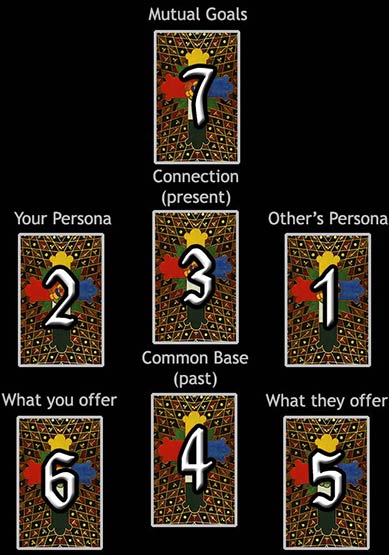
Difficulty: Easy
This relationship spread focuses more on the common ground of the relationship, with three cards in the middle column showing the common ground. The middle column essentially displays the past, present, and future of the relationship.
Card #4 stands for the common base of the relationship, which may be thought of as the past events which have shaped their characters, bringing them together. The current connection that binds them together is Card #3, indicating the values shared. Card #7 implies the common goals that would keep the pair together moving into the future.
The columns on either side show what each partner brings to the table. Remember, relationships need not be romantic, and the partners could even be groups rather than individuals. In this layout, the other person is on the left-hand side and the reader on the right.
Cards #1 & #2 indicate the separate personalities of each member of the relationship. These cards form a sort of bridge with the cards beneath them, #5 & #6, which show the qualities that each partner offers the other person, and thus to the relationship as a whole.
Your Relationship #2 Reading
Mutual Goals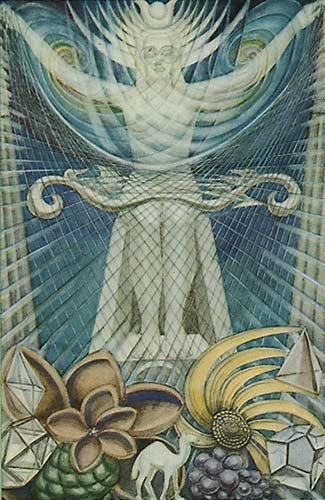 |
||
Your Qualities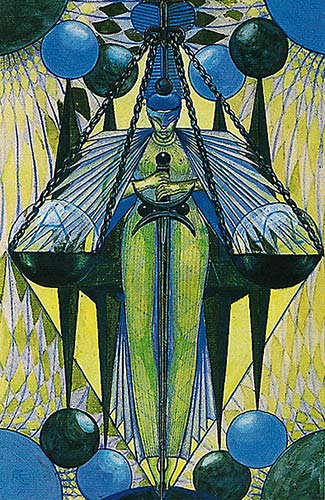 |
Connection (Present)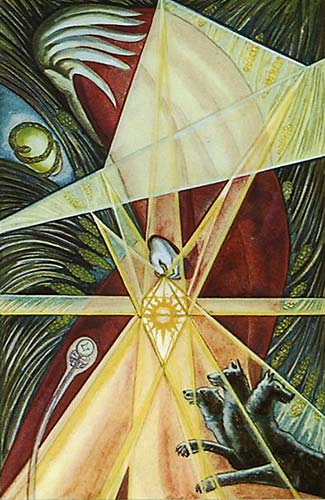 |
Others' Qualities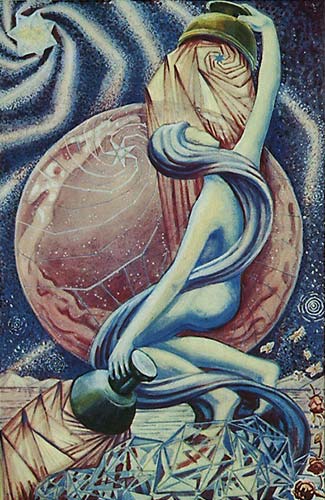 |
What You Bring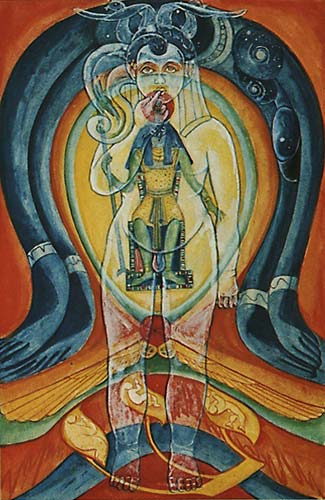 |
Common Base (Past)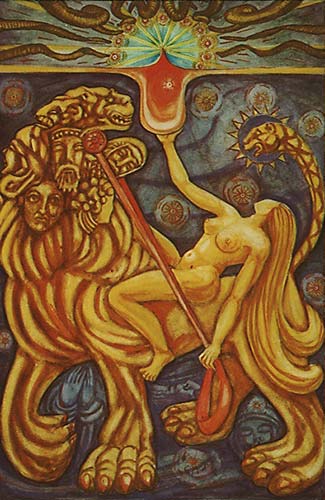 |
What They Bring 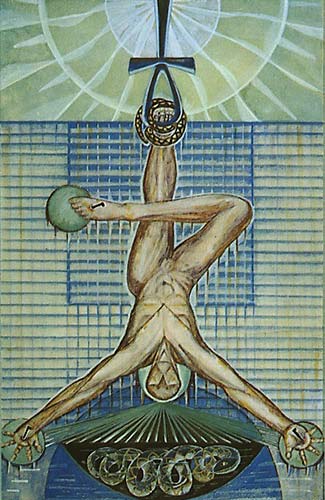 |

7: Mutual Goals
II – The Priestess
(Moon, Gimel)
The Priestess is a figure of serene and inscrutable wisdom, embodying the mysteries of the subconscious and the cycles of the Moon. She corresponds to Gimel, the camel, representing the capacity to traverse vast spiritual deserts and access hidden truths. The Moon's influence lends her an air of receptivity, intuition, and connection to the rhythms of the cosmos.
Seated on her throne, the Priestess holds a bow, an emblem of Artemis and lunar cycles, symbolising her mastery of timing and precision. Her arms mirror the crescent moons of the background, merging her form with the sea of the unconscious. Before her, a tapestry adorned with pomegranates and palms veils the sacred mysteries, separating the seen from the unseen. At her feet lies the crescent moon, a symbol of her dominion over intuition and the waxing and waning cycles of existence.
In Relationships: The Priestess indicates the presence of profound emotional depth and unspoken bonds. It encourages you to trust your intuition and explore the layers of your connection without rushing to conclusions.
In Work: This card suggests the answers lie in reflection and inner knowledge rather than external action. It advises you to trust your instincts and remain patient while the path unfolds.
Spiritually: The Priestess represents the deep well of inner wisdom, the gateway to divine knowledge. She calls you to explore your dreams, meditations, and intuitions for insight into the mysteries of the self and the universe.
When ill-dignified: The Priestess cautions against passivity, confusion, or ignoring intuitive warnings. You are advised to confront hidden fears and distinguish between genuine intuition and projections of the unconscious mind.

3: Connection
IX – The Hermit
(Virgo, Yod)
The Hermit represents the seeker of inner truth and the wisdom gained through solitude and introspection. Associated with Yod, the hand, this card embodies the divine spark of creation and the active quest for enlightenment. Virgo, the zodiac of analysis and service, lends the Hermit its meticulous and introspective energy.
The Hermit is a lone figure cloaked in red, symbolising both the concealment and revelation of profound mysteries. He holds a glowing lantern containing a star, representing the union of opposites and the illumination of divine wisdom. A serpent coils around the cosmic egg, an emblem of transformation and esoteric knowledge. In the foreground, a radiant yellow glow symbolises enlightenment, while the crop around him suggests the fertile soil of the unconscious mind.
In Relationships: The Hermit suggests introspection or solitude. It encourages you to seek clarity and the understanding of your own needs before reengaging with others.
In Work: This card indicates the value of independent effort and the importance of inner guidance. You are encouraged to trust your own wisdom and focus on long-term goals rather than immediate results.
Spiritually: The Hermit represents the solitary journey of self-discovery and pursuit of higher knowledge. It calls you to turn inward and seek truth through meditation and reflection.
When ill-dignified: The Hermit warns of isolation, excessive withdrawal, or a reluctance to share one's insights. You are advised to balance your introspection with meaningful connection and ensure you are not avoiding life's responsibilities.

4: Common Base
XI – Lust
(Leo, Teth)
Lust, known as Strength in many other decks, takes on a unique and profound meaning in the Book of Thoth. This card signifies the ecstatic embrace of life's passions and the power derived from uniting primal instincts with spiritual purpose. Associated with Teth, the serpent, it symbolises both the kundalini energy and the continuous cycles of transformation and renewal. Leo, the zodiac of courage and vitality, infuses the card with boundless confidence and creative expression.
The central figure is a woman riding a multi-headed beast, a symbol of primal forces mastered and directed towards a higher purpose. Her nudity represents authenticity and fearlessness, while the cup she holds aloft is the Holy Grail, symbolising the ultimate spiritual goal. The beast itself, covered in fiery hues, represents the dynamic power of creation, destruction, and renewal. The background is filled with swirling red and gold, reflecting the intensity of life force and divine energy.
In Relationships: Lust represents passion, desire, and a fearless embrace of emotional intensity. It encourages you to fully engage with your relationships, revelling in love's transformative power.
In Work: This card signifies success achieved through boldness, enthusiasm, and a connection to one's creative instincts. You are advised to channel your energy into projects that ignite your passion.
Spiritually: Lust symbolises the awakening of spiritual vitality and integrating one's primal and divine natures. It calls you to surrender to the ecstatic flow of universal energy.
When ill-dignified: Lust warns of unchecked desires, destructive passions, or an overindulgence in material pleasures. You are advised to restore balance and align your desires with a higher purpose.

2: Your Qualities
VIII – Adjustment
(Libra, Lamed)
In the Thoth deck, the card traditionally known as Justice is renamed Adjustment, reflecting the dynamic nature of balance and the constant recalibration required to maintain harmony. Associated with Lamed, the ox-goad, it represents the guidance and discipline needed to align oneself with universal truth. Libra, the zodiac of balance and fairness, infuses the card with its themes of equity and measured judgement.
The central figure of Adjustment is a serene androgynous figure holding a sword while balancing on their toes, between a balanced pair of scales. The sword symbolises the piercing clarity of truth, while the scales represent the cosmic law of cause and effect. Their poised stance is framed by geometric patterns, emphasising precision and the mathematical order of the universe. Behind them, a brilliant green background evokes the idea of renewal and the living equilibrium of nature.
In Relationships: Adjustment highlights the importance of honesty, fairness, and mutual accountability. It encourages you to communicate openly and seek a balanced dynamic.
In Work: This card suggests success will come through careful analysis, ethical decision-making, and the ability to adapt to changing circumstances. It warns against cutting corners or ignoring the consequences of actions.
Spiritually: Adjustment signifies alignment with divine truth and the quest for inner harmony. You are called to reflect on your actions and ensure they are in alignment with your highest principles.
When ill-dignified: Adjustment warns of imbalance, dishonesty, or an inability to take responsibility for one's actions. You are advised to confront uncomfortable truths and restore equilibrium through introspection and accountability.

1: Their Qualities
XVII – The Star
(Aquarius, Heh)
The Star represents hope, inspiration, and the flow of divine energy. Associated with Heh, the window, this card symbolises clarity and the opening of the soul to cosmic light. Aquarius, the zodiac of vision and humanitarian ideals, imbues the card with themes of enlightenment and universal connection.
The central figure is a nude woman, representing purity and vulnerability, pouring water from two vessels—one onto the earth and the other into a pool, symbolising the balance between spiritual and material realms. Behind her, a radiant star dominates the sky, surrounded by smaller stars, signifying guidance and hope. The background, rich with blues and violets, evokes the tranquillity of the natural world.
In Relationships: The Star suggests healing and renewed hope. It encourages you to trust in the flow of love and remain open to its guidance.
In Work: This card signifies inspiration and creative potential. You are advised to trust your intuition and align your efforts with a higher vision.
Spiritually: The Star symbolises a connection to the divine and the flow of universal energy. It calls you to share your gifts and have faith in the cosmic plan.
When ill-dignified: The Star warns of disillusionment, a loss of faith, or a failure to see one's potential. You are advised to reconnect with your inner light and trust in the process of renewal.

6: What You Bring
XX – The Aeon

5: What They Bring
XII – The Hanged Man
(Water, Mem)
The Hanged Man represents surrender, transformation, and the wisdom gained through self-sacrifice. Associated with Mem, the waters, this card embodies the flow of unconscious depths and the mysteries that lie beyond the material world. It is not a card of suffering but one of enlightenment through letting go.
The central figure is suspended upside-down, forming a cross with his legs, a symbol of balance and sacrifice. His arms form a triangle, evoking the union of spirit and matter. Behind him, the swirling blue-green background suggests the ocean of the subconscious. The serene expression on his face reflects the tranquillity found in surrendering to a greater truth. Around him, rays of light emanate, signifying the revelation that arises from this state of suspension.
In Relationships: The Hanged Man suggests a need for patience, selflessness, and understanding. It encourages you to see things from your partner's perspective and release control.
In Work: This card indicates a period of pause or sacrifice, where immediate goals may need to be set aside for long-term growth. You are advised to trust in the process and focus on the bigger picture.
Spiritually: The Hanged Man symbolises enlightenment achieved through surrender and the release of ego. It calls you to embrace the transformative power of stillness and contemplation.
When ill-dignified: The Hanged Man warns of stagnation, resistance to change, or clinging to outdated beliefs. You are advised to let go of what no longer serves you and embrace the wisdom of surrender.